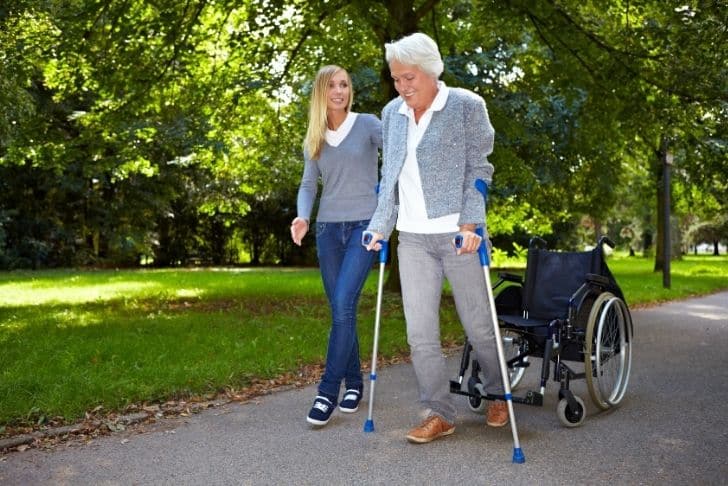In the enlightening article titled, “The Role of Mobility Devices in Improving Seniors’ Quality of Life,” you’ll uncover an engaging exploration of top mobility solutions for seniors, tailored for diverse environments. From classic canes supporting up to 25% of the user’s body weight to more comprehensive aids like wheelchairs, the piece encompasses an array of options meticulously chosen to address varying degrees of mobility challenges. Move around comfortably with potent alternatives to canes, like walkers and rollators, or opt for mobility scooters if longer distances are part of your routine.
For those in need of a little extra help at home, the article details beneficial fixtures like grab bars, stairlifts, vertical platform lifts, and wheelchair ramps. With their ultimate goal being to elevate the quality of life by fostering confidence, safety, and independence, these mobility aids also encourage increased community involvement among seniors. Finally, the article emphasizes the value of trying out different models at retailers like Mobility Plus Colorado and consulting medical professionals before settling on your ideal device.
Understanding Mobility Aid Devices
It’s essential to understand mobility aid devices—a key instrument that helps maintain independence in seniors experiencing mobility issues. These devices support the body, enabling you to move from one place to another, performing day-to-day tasks with minimal assistance.
Types of Mobility Aid Devices
Mobility aid devices come in different types, including canes, walkers, rollators, wheelchairs, scooters, and home mobility devices. The choice of aid depends on your unique mobility needs, physical condition, environment, and personal preference.
Importance of Mobility Aid Devices for Seniors
Mobility aid devices significantly influence the standard of living for seniors by promoting independence, reducing the risk of falls, increasing self-confidence, and ensuring safety. Mobility issues can lead to isolation, loneliness, and depression in aging individuals. These devices can alleviate these challenges by promoting easier navigation and social engagement.
Influencing Factors in choosing a Mobility Aid Device
The choice of a mobility aid device relies largely on an individual’s mobility requirements, physical strength, comfort, lifestyle, and costs. Engaging with a medical professional and your family will provide a clearer picture of what device suits you best.
Trialling Different Mobility Aids
Testing different mobility aids allows you to learn firsthand how each device works, the level of support it provides, and its ease of use. It’s an opportunity to identify what feels right for you, helping to make an informed choice.
Detailed description of mobility devices suitable for seniors
Overview of Various Mobility Aid Devices
There are several types of mobility aids, each serving a unique purpose. They include canes, walkers, rollators, mobility scooters, and wheelchairs. The right aid to you would depend on your specific needs and preferences.
How Each Device Works
Each mobility aid device operates differently. Devices such as canes and walkers offer balance and take some weight off a weaker side in the body. On the other hand, mobility scooters and wheelchairs provide broader support services, accommodating those who can’t walk or stand for long.
Benefits and Drawbacks of Each Device
All mobility aids have their pros and cons. Canes, for instance, are lightweight but provide limited stability compared to walkers and rollators, which deliver more support but are bulkier. Wheelchairs and scooters offer rested mobility but limit physical activity, which might affect your overall fitness.

The use of Canes in elder mobility
History and evolution of Canes
Canes have been around for centuries, serving initially as a social signifier before progressing into a vital mobility aid. Today, they have diversified in design, material, and form, reflecting a variety of individual needs and styles.
How Canes Support the User
Canes provide valuable support by bearing up to 25% of your body weight, easing pressure on your lower body. They are particularly beneficial for people experiencing minor balance issues or partial weight-bearing restrictions.
Different Sizes and styles of Canes
Canes come in myriad sizes and styles—from simple single-point canes and quad canes to fashionable and chic designer ones. It’s crucial to pick a cane that reflects your style while offering all necessary support.
Choosing the Correct Cane
Selecting the right cane depends on your height, the amount of weight it needs to support, and your sense of style. It should be of a height that doesn’t strain your hand and strong enough to bear your weight.
Walkers and Rollators as mobility aids
Understanding the Difference Between Walkers and Rollators
Although both walkers and rollators provide balance and stability, rollators come with wheels on all legs, a seat, and often a basket. They offer better mobility but require slightly more control than walkers, which are more stable but less flexible.
How Walkers and Rollators Provide Support
Walkers and rollators can support up to half of your body weight, providing all-around balance, especially if you have severe balance issues or a higher weight-bearing necessity.
Ideal Candidates for Walkers and Rollators
They’re ideally suited to individuals who can stand but require extensive support to move around. Walkers better serve those with considerable control issues, while rollators are better for people with more rigorous mobility demands.
Customizing Walkers and Rollators for Improved Comfort
You can incorporate several enhancements to your walker or rollator, such as seats, baskets, brakes, and all-terrain wheels. This customization improves comfort, safety, and practicality.

Role of Mobility Scooters in enhancing mobility for the elderly
Understanding Mobility Scooters
Mobility scooters are battery-powered vehicles that provide easy mobility over relatively long distances. They have a seat over two rear wheels, a flat area for the feet, and handlebars with a control unit to steer the front wheel(s).
Who Can Benefit from Mobility Scooters
If you tire quickly but can sit upright without support, a mobility scooter is an excellent option. It aids in maintaining independence, especially for extended outdoor periods.
Range of Models and Accessories
Mobility scooters range in size, from compact, portable scooters to heavy-duty ones for harsh terrains. Common accessories include baskets, canopies, oxygen holders, and battery upgrade options for extended use.
Balancing Functionality and Size in Selecting a Suitable Mobility Scooter
While choosing a mobility scooter, it’s crucial to attain a balance between size—dictating its maneuverability and portability, and functionality—defining its speed, range, and rider capacity.
Wheelchairs as a comprehensive mobility solution
Understanding the Different Types of Wheelchairs
Wheelchairs can be manual—propelled by users or helpers, or power—driven by a battery. Other types include transport wheelchairs, specifically designed for temporary use during transportation.
Choosing the Right Wheelchair
Selecting the right wheelchair depends on your individual requirements, including the level of support needed, the nature of use—indoor or outdoor, your physical strength, and even your environmental conditions.
Safety and Comfort Considerations When Using Wheelchairs
Safety features such as seat belts, anti-tip bars, and wheel locks are crucial in a wheelchair. Comfort considerations include a well-padded seat, adjustable arm and footrests, and back support.
How Wheelchairs Provide More than Just Mobility Support
Wheelchairs provide not only mobility support but also comfort during long periods of use, a crucial factor for seniors who might have to stay in them for extended periods.

Introduction to Home Mobility Devices
Understanding home-based mobility aids
Home-based mobility aids include grab bars, stairlifts, vertical platform lifts, and wheelchair ramps. They are designed to facilitate easier navigation within your home environment.
Importance of Home Mobility Devices
These devices maintain safety around the house, enabling you to move around and perform daily activities independently and comfortably.
Range of Products Available
Several home mobility aids cater to different needs. For instance, grab bars assist in moving around the bathroom, while stair lifts help navigate multiple floors. Wheelchair ramps improve accessibility, while platform lifts help overcome vertical barriers.
Customizing Home for Ease of Navigation
It’s essential to customize your home based on your mobility demands. This may include installing ramps instead of stairs, installing grab bars at strategic points, or even placing household items within accessible reach.
Prerequisites to Purchasing Mobility Devices
Engaging Medical Professionals in Decision-Making
It’s crucial to involve medical professionals during the decision-making process. They can provide informed advice based on your physical condition, strength, and mobility requirements.
Involving Family in Selecting Mobility Aids
Your family knows your lifestyle and preferences best. Including them in the selection process ensures you choose a device that fits your style and complements your way of life.
Experience the Device Prior to Purchase
Testing the device before purchasing ensures you know exactly what you’re getting, helping you anticipate and understand its functionality while gauging its suitability in your daily life.
Implications of Choosing the Wrong Mobility Aid
The wrong mobility aid could lead to discomfort, underuse, and a heightened risk of falls. Therefore, understanding your needs and seeking professional advice prioritizes safety, benefits, and overall user experience.
Role of Retailers in Mobility Device selection
Understanding the Function of Mobility Aid Retailers
Mobility aid retailers provide an extensive range of mobility aids, offering you a chance to test and compare different devices, further assisting you in choosing the right one.
Benefits of Visiting a Showroom
Visiting a showroom allows you to see a variety of mobility aids, test them out, and seek expert advice. This exposure offers an experience-based understanding of your mobility aid choices.
How Retailers like Mobility Plus Colorado are Supporting Decision-Making
Retailers such as Mobility Plus Colorado offer not just a wide variety of mobility aids, but also comprehensive consultancy services providing valuable insights and personalized service for your unique needs.
Ensuring After Purchase Support from Retailers
Post-purchase support is crucial, as it includes services such as maintenance, upgrades, and potential part replacements, ensuring the longevity of your device.
Impact of Mobility Devices on Seniors Quality of Life
Increasing Confidence and Independence
Mobility aids offer increased confidence while navigating, fostering a sense of self-reliance and independence. Having a mobility device that suits you enables you to perform daily tasks with minimal assistance.
Enhancing Safety
By providing balance and support, mobility aids improve safety, lowering the risk of falls—a common risk among the elderly.
Fostering Community Engagement
Mobility aids encourage seniors to stay socially active, facilitating community engagement, and overall enhancing quality of life.
Adjusting to the Changing Needs of the Senior
With aging, mobility requirements may evolve. The right mobility aid caters to these changing needs, maintaining comfort and independence throughout the senior’s changing life phase.
